

Electronics Technical Hub > The Mr. Tech Guide > All you need to know about LEDs (Light emitting diodes)
All you need to know about LEDs (Light emitting diodes)
This information was provided by

RS’s Easy Q&A Guide to steer your way towards quick insight

Cell phones, liquid crystal displays, vending machines: A tremendous amount of LEDs have been recently replacing conventional light sources in many products. Think about it … Cell Phones, Liquid Crystal Displays (LCDs), Vending Machines, etc. They all have LEDs in them. Why? Mainly, LEDs’ properties of high efficiency and low power consumption are just too useful to be ignored. On top of that, usage of LEDs are deemed environmentally friendly, and highly encouraged by conservationists worldwide.
What are LEDs?
“LED” is short for “light-emitting diode”. LEDs are devices that emit light when an electrical current is applied to them. They are a type of diode, so that is why they are called light-emitting diodes.
The Advantages of Using LEDs
Unlike light bulbs, LEDs do not burn out after a short period of time, and can be used semi-permanently, depending on their intended use. Because they have uniform wavelengths, their colours are sharp and they emit light beautifully. Their responsiveness is excellent compared to that of light bulbs, etc.
Their power consumption is extremely low compared to that of conventional light sources. Compared to light bulbs, etc., there is hardly any heat generated by them (excluding high power LEDs). LEDs can be used to emit light in a variety of colours from items that have no colour themselves.
The Disadvantages of Using LEDs
Because LEDs are a point light source, their viewing angle (the angle from which their light can be seen) is often smaller compared to that of light bulbs, etc. Other parts are necessary, in order to use them correctly (resistors, constant current diodes, etc.).
Types of LEDs
(1) Bullet LEDs
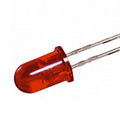
As the name suggests, these LEDs are in the shape of a bullet. There are many sizes, based on diameters of 3, 5, and 10mm. There are two types of external moulds: those with coloured diffusion packages, and those with colourless, transparent packages. The diffusion package type is used when a wide viewing angle is preferred over strong emission luminosity, and the colourless, transparent package type is used when it is better to conceal the colour of the emitted light when the LED is turned off.
(2) Chip LEDs
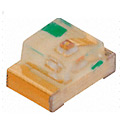
Chip LEDs are surface-mounted LEDs. The LED element is enclosed within a chip-shaped package. Like the bullet LEDs, there are colourless as well as coloured packages. Inside the package is a component that has undergone a reflection treatment (a component that efficiently directs light from the chip to the display surface).
(3) Segment displays
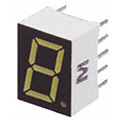
Segment displays are packages divided into 7 or 16 segments in order to display numbers. “7-seg” displays are in the shape of the number “8”, split into seven elements, and are used to display numbers in digital clocks and so forth. There are many sizes of segment displays. There are common anode segment displays and common cathode segment displays, the selection of which is determined by the control method (due to current directionality).
(4) Dot matrix displays
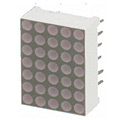
Dot matrix displays are display devices with 5x7 or other configurations of LED elements evenly lined up and contained in one package. They can be used for complicated displays not possible with 7-seg displays.
(5) High power LEDs
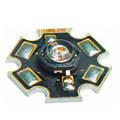
High power LEDs have LED elements enclosed in multiple packages. They have high emission densities and are extremely bright, but because heat dissipation from the package is not possible, heat countermeasures are necessary.
(6) Infrared and ultraviolet LEDs
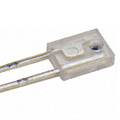
LEDs normally emit visible light, but there are also LEDs that emit infrared and ultraviolet light.
Units
- If :
- Forward current
- Vf :
- Forward voltage
- Vr :
- Reverse voltage
- Pd :
- Acceptable loss
- λp :
- Peak emission wavelength *
- Δλ :
- Spectral half-width *
- λd :
- Dominant wavelength *
- Iv :
- Luminosity; units are in candelas (cd) or lumens/steradian (lm/sr)
- F :
- Luminous flux; units are in lumens (lm)
- B :
- Luminance; units are in nits (nt) *n = 1cd/m2
* Different expressions are used by different manufacturers












